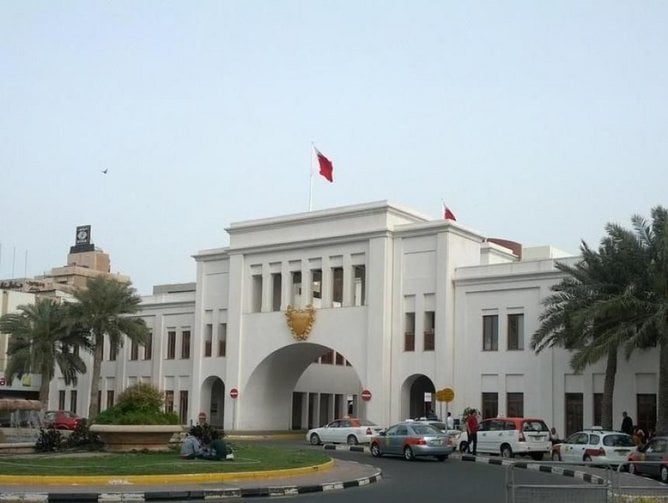IT, IT Strategy, Infrastructure and Innovation, Complex IT Environment
Taufik Kurniawan has had an eventful career. Originally from Indonesia, he started up as a network engineer at Schlumberger, the world’s largest oilfield services company. Kurniawan worked his way up to become project manager, and then settled as an IT project manager. From there, he caught the attention of multinational company WorldCom; he helped to develop its business in Indonesia. He then worked a technical service advisor at one of the biggest group of IT companies in Indonesia, Sigma.
Kurniawan tells us about his departure from Indonesia. “11 years ago, there was an offer from Bahrain. It was a good opportunity, so I took that opportunity,” he explains. “I started here as an ICT project manager for the implementation of ICT infrastructure in Bahrain World Trade Centre - an iconic building.
Kurniawan stayed in this role until 2005, when his team had completed the project. Impressed with his work, Kurniawan’s boss asked him to assist with another venture. The offer materialised into Kurniawan’s current role: heading the IT infrastructure for a semi-governmental organisation.
“It’s an honour for me to help set up the IT organisation. It started with only seven employees, now it has over 25 people. It started as an unorganised IT structure, it’s now a well-managed IT organisation”, Kurniawan triumphs.
Despite Kurniawan’s enthusiasm, the process to development wasn’t simple. When arriving in Bahrain, Kurniawan found that the IT infrastructure and environment differed hugely from Indonesia’s.
“Bahrain is a small country, with approximately more than one million people here and the IT vendors are very limited. During my early years in Bahrain, we invited several vendors to implement some projects and their quality of work was not to my expectation. Although I am not a perfectionist, I always want to do something perfectly and way beyond expectations. Then my boss and I decided to develop and train our own internal resources instead,” Kurniawan explains.
Despite the limited technology provider and partner in, Kurniawan managed to produce a progressive IT strategy in his current role. He constructed a road map; an IT strategy of how the team was going to achieve an improved IT infrastructure in five to 10 years.
Kurniawan feels that Bahrain needs to be able to see a modern and complex IT environment in the rapidly changing business environment, through simplifying IT strategies.
“I always think that IT strategy should be simple and easy to implement, in whatever organization we are, be it in government, education, healthcare, energy, service provider, banking and finance, telecommunication etc., the IT strategy is started from the organization business mission or objectives,” Kurniawan comments.
He stresses the importance of a comprehensive IT strategy; it identifies the requirements of achieving the objective in the area of capital investment, human resources, standard business process, and later implements the tools to deliver the services.
“Depending on the organisations goals and objectives; we often see it as transformation, as a business enabler. IT supports business and IT and business alignment/integration that would dictate our IT strategy.”
Kurniawan continues: “IT strategy is simply building and developing secure, reliable and scalable IT infrastructure, then operating with a service mindset at heart.
Successful IT strategy and implementation requires a holistic approach of all three important strategy components: people, process and technology.”
According to Kurniawan, there’s a need to prepare the soldier behind the gun - the right people with sufficient skills and knowledge. Kurniawan’s team develops and trains their internal resources to be able to run and operate with efficient processes of their tasks, activities and procedures documented. They then deploy technology solution surrounding people and processes as per organization requirements to achieve their business objectives. It includes hardware, software and brainware.
“IT strategy is an interesting art in applying IT standard, frameworks and references to our unique business or organisational environment,” Kurniawan says. “Many IT standards, frameworks and references are defined such as IT governance, IT services, enterprise architecture, but the beauty is how we adapt those to our unique environment to get the most benefits of them for our organisation.”
Kurniawan chooses the motto “simple is beautiful” when implementing IT strategy to the organisation
An example of this is resource pooling approach, Kurniawan adds: “The idea was to optimise the utilisation of any IT resources we already have and make it scalable. There were so many scattered IT resources and I want to pull them together to make a centralised IT resource-pooling. It started with building a tier 3 data centre to consolidate several scattered computer room. We consolidated and centralised all the IT servers, IT equipments, IT applications, business applications (which are previously scattered here and there in several computer rooms).”
With same approaches in minds, Kurniawan’s team do the same thing for centralised printing, centralised wireless internet, BYOD, IoT, centralised security system, cloud infrastructure, IP Telephone and ERP.
In order to support employee productivity and efficiency through mobility, the team implement the advanced solution from Avaya portfolio. Not only does IP collaboration from Avaya increase staff productivity and efficiency, but it also reduces the operational cost of communication.
With Kurniawan at the helm, the team produced a fibre-dedicated private network. For security reasons, they made a dual independent each other network in order to separate sensitive data and public facing information. The networks interconnects 19 locations across Bahrain. “These two networks are similar in size and in topology architecture, however there is no connectivity between the two, they are independent .We take very serious security measures for our internal confidential data and information,” Kurniawan describes. “Our network is very robust, very highly redundant, very high speed and yet secured.”
Each scattered location has its own internet connection, resulting huge operational costs. Having experience of building and developing more than 6 ISPs in Indonesia and the first ISP in Nigeria, Kurniawan quickly decided to build a mini-scale ISP for the organisation and centralised the Internet services (Internet access and internet email servers).
Kurniawan stresses that within the organisation, there’s no excuse for poor connectivity and downtime.. After establishing the infrastructure, the team centralised the connectivity with four service providers for a highly redundant uplink. The mini-scale ISP proofed to reduce operational costs and at the same time improve reliability, scalability and security.
As for the process strategy, Kurniawan’s team engage with business consultants to standardise and reengineer the business process, based on the combination of existing and commonly practiced process with the best practice in the industry and then we implement the process and map them in our ERP Software implementation. We implement the most notable ERP software in the market for our organisation.
Vendors and technology partners are key to the infrastructure development process; Kurniawan ensures that he picks the best ones. “So many vendors meet me and my team. They say, ‘you know what you are doing!’ and try to sell their professional services to us,” Kurniawan says.
Unfortunately for these vendors, the team very rarely contract people in this manner. “Mostly what happened was we study and do the research ourselves, we design ourselves, and then we identify the product that we require. Only then do we engage the vendor and technology partner.”
Kurniawan’s team negotiates with a technology principal rather than contacting the local vendor directly. Kurniawan and the principle collaborate on design and identify the programme they require. After an agreement is made, the principal engages with their local partner.
Not only does Kurniawan build relationships with internal partners, he also forges links with foreign firms. “I have an interesting story,” Kurniawan begins. “There are several products which didn’t exist in the GCC region before we, as an organisation, introduced them to the region. These products met our requirements, they fit our design goals, however they were not having any presents in the region. Many of these products come from a two to three-year-old start-up IT company. Arista Networks –is one of the products which fits our technical requirements and existed here before we invited them to come to the region.”
They also invited scale-out storage start-up products that are suitable for their cloud-computing infrastructure – an area that fascinates Kurniawan. “Cloud technology is very interesting,” he tells us, before explaining how he dabbled in the practice before he even knew what it was called. Four years ago, Kurniawan made a road map called Corporate IT Infrastructure (CITI), that eventually became known as Infrastructure as a Service (IaaS in cloud terminology).
“I have been lucky to have several strategic technologies partner that committed to help our organisation. Previously, whenever there was an IT project, we always have a requirement of servers, storage and network. We end up with so many unstructured landscapes. At the time, I had an idea to consolidate all of this. I designed a service layer, network layer, storage layer, application layer, platform layer and virtualisation,” Kurniawan explains. “During this time we collaborated with scale-out storage start-up. Our design was very simple, but integrated and we avoided being locked by any vendors. We called our approach as “ Loosely Coupled, Tightly Integrated.”
Because all Kurniawan needed was memory capacity, computing capacity and network connectivity, he had flexibility. “I can use any servers. I can use servers from a big-name vendor A, vendor BC, vendor DEF. Even I can use any white box servers with an unknown brand, I can use it because as long as they have a CPU, they have a memory and they have a network connectivity,” he tells us.
This architecture requires a fast, low-latency and high density data centre network requirement, which leads the team to a start-up networking solution from Arista Networks and a scale-out storage strategy which leads them to also a start-up cloud storage solution.
“By implementing this architecture, we achieve a simple architecture, yet it is reliable, scalable and agile. Even it is much cheaper compared to any other solutions from the big-name IT vendor,” Kurniawan says.
Most IT vendors flood their product with lots of features, and most of the time we require only few of them. So when the team focus on those few specifications usually they can reduce the initial investment. There is no exception with cloud computing infrastructure.
My good example was when we were required to have a powerful operating system with high availability cluster configuration for both ERP solution and centralised corporate database in our cloud infrastructure. My quick analytical thinking lead to *Nix, then Linux and eventually to Suse Linux Enterprise Server (SLES).
-
A year later, cloud computing was booming. “I realised what I was doing was called Infrastructure as a Service in cloud computing terms. Cloud computing starts with consolidation, optimisation, virtualisation, standardisation and automation.” Kurniawan says. However, his team don’t do automation, as they only implement a certain level of cloud computing as per requirements.
As for implementing IT infrastructure for the organization, Kurniawan is happy that:
- Agile and scalable infrastructure accelerates the solution delivery to the business, which practically can be done by IT resource pooling, cloud infrastructure and automation.
- Cost reduction and efficiency achieve through the reuse of IT resource pooling, business process automation and support maintenance optimisation.
- A roadmap of infrastructure is created based on existing system to achieve future envisioned it ecosystem.
Regarded as an interesting case study, Kurniawan shared his experiences in several well known IT conferences such as CloudAsia, Cloud Computing World Forum and Datacentre Dynamics.
Cloud computing is incredibly popular at the moment, but how does Kurniawan see himself using his IT expertise in the future?
“I want to do this for as long as possible, then in the future I want to share my expertise and knowledge in my home country. Maybe I’ll teach in a university part-time, or something like that,” he considers.
Kurniawan is excited about the future, but for now he’s satisfied working with his team, developing new ways to improve IT infrastructure for his Bahraini client. For Kurniawan, this is his ideal job. “It’s like a dream,” he tells us. “It’s amazing.”






